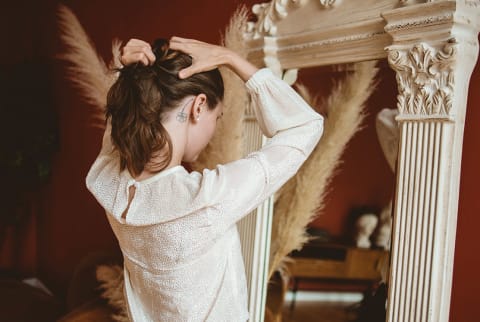Your Slicked-Back Ponytail Could Lead To Hair Loss — How To Avoid It


One popular way to sneak around wash day is by throwing your hair in a slicked-back ponytail or bun. This is a quick and relatively easy solution to oily strands (without loading on the dry shampoo) that looks stylish at the same time. Here's a quick guide on how to master this style, if you're curious.
But like many buzzy beauty ventures (exfoliation, protein-rich hair treatments, et al.), it's possible to go overboard. Unfortunately, overdoing the slicked-back look can wreak havoc on your hair and even result in localized hair loss, among other forms of breakage. Don't sound the alarm just yet: Below, we asked board-certified dermatologist and hair loss expert Ben Behnam, M.D., FAAD, why this occurs and how to prevent it.
How slicked-back ponytails can cause hair loss.
Pulling your hair into a tight elastic can cause breakage on the strands themselves, especially where the elastic is secured. While this is worrisome, losing hair at the root may be more serious, as it can result in more long-term hair loss. This is called traction alopecia.
"Traction alopecia means when patients repeatedly put their hair in a tight [style], and over time this starts pulling out some of the hairs on the sides, literally killing those hairs," Behnam tells mbg. So while it may look nice to have an ultra-tight and sleek pony, it can literally tug your hair out with time.
Ponytails and buns can certainly lead to traction alopecia, but Behnam warns that tight braids can be even more dangerous; so if you frequently do protective styles (flat twists, cornrows, and box braids), experts recommend switching out your braids every two weeks, and be sure to give yourself breaks in between.
Overdoing too-tight hairstyles can not only kill the hair at the root and damage the existing strands, but they can even lead to permanent scarring1 if left untreated. When this occurs, there's little hope to regain hair growth in that area at all, even with professional treatment. Translation? If you think you might be dealing with traction alopecia, you'll want to waste no time addressing the issue.
How to prevent traction alopecia.
The best way to prevent traction alopecia is to style your hair in loose ponytails and braids rather than tightly pulling and tugging on your strands. Of course, a slicked-back style is A-OK every once in a while, but it shouldn't be an everyday occurrence. Further, if you're already prone to hair loss, you might want to avoid these tight styles in general.
Taking good care of your hair (scalp included) is also always important, but especially if you're constantly styling your hair. You want your strands hydrated and your scalp thriving in order to prevent hair loss and breakage. Might we suggest one of these hydrating hair masks?
A few good practices to add to your hair care routine include regularly massaging your scalp with hair growth serums (especially those that contain rosemary oil) and perhaps taking a daily healthy hair supplement. Here's more information on why these hair vitamins work, plus where to find them.
Finally, if you're dealing with increased shedding, it's important to get to the root of the issue. While tight styles contribute to traction alopecia specifically, hair loss can be brought on by a number of factors, which you can read about here.
The takeaway.
It's tempting to throw your hair in a slicked-back ponytail every time you skip wash day, but it's not a healthy habit to rely on daily. Tight styles like this can lead to traction alopecia and cause hair loss and scarring if you overdo it. Instead, style your hair in a loose-fitting ponytail or braid. You can reach for dry shampoo as well, but remember to use cleansing washes or scalp scrubs to remove buildup every once in a while. Taking care of your hair day to day is important regardless, so here are 22 healthy hair tips to get you started.

Hannah Frye is the Assistant Beauty & Health Editor at mindbodygreen. She has a B.S. in journalism and a minor in women’s, gender, and queer studies from California Polytechnic State University, San Luis Obispo. Hannah has written across lifestyle sections including skin care, women’s health, mental health, sustainability, social media trends, and more. She previously interned for Almost 30, a top-rated health and wellness podcast. In her current role, Hannah reports on the latest beauty trends and innovations, women’s health research, brain health news, and plenty more.
-v1646695196476.jpg?1148x800)